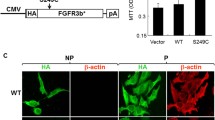Abstract
Hyperplasia of transitional cell epithelium adjacent to human transitional cell carcinomas (TCC) is a common finding in pathology. This hyperplasia may be a precancerous aberration. Alternatively, it has been suggested that the hyperplasia is due to paracrine action of tumour-derived growth factors. In this study we tested the latter hypothesis using the mouse tumorigenic TCC cell line NUC-1. Transplantation of NUC-1 tumour cells into the urinary bladder submucosa of syngeneic mice in vivo induced hyperplasia of normal adjacent urothelium in all tested mice. Implantation of normal mouse bladder mucosa did not induce urothelial hyperplasia. In vitro, conditioned medium of NUC-1 cells induced the proliferation of the mouse urothelial cell line g/G, which closely resembles normal urothelial cells. This induction was inhibited by transforming growth factor β1 (TGFβ1). Similarly, TGFβ1 inhibited the fibroblast growth factor-1 (FGF-1) and FGF-2 induced proliferation of g/G cells. Chemico-physical examination, bioassays with conditioned media, and RNA analysis of NUC-1 cells revealed that these cells secreted a growth factor with FGF-like properties. These results indicate that epithelial hyperplasia surrounding carcinomas is not necessarily a precancerous aberration, but may result from direct paracrine action of tumour-derived growth factors.
Similar content being viewed by others
References
Aaronson AS (1991) Growth factors and cancer. Science 254:1146–1153
Brünger R, Schubert GE (1987) Urothelial histopathology surrounding bladder carcinoma. Eur Urol 13:156–162
Carpenter G (1985) Epidermal growth factor: biology and receptor metabolism. J Cell Sci [Suppl] 3:1–9
Chang F, Syrjänen S, Shen Q, Ji H, Syrjänen K (1990) Human papillomavirus (HPV) DNA in oesophageal precancer lesions and squamous cell carcinomas from China. Int J Cancer 45:21–25
Chodak GW, Hospelhorn V, Judge SM, Mayforth R, Koeppen H, Sasse J (1988) Increased levels of fibroblast growth factor-like activity in urine from patients with bladder or kidney cancer. Cancer Res 48:2083–2088
Chopin DK, Caruelle J-P, Colombel M, Palcy S, Ravery V, Caruelle D, Abbou CC, Barritault D (1993) Increased immunodetection of acidic fibroblast growth factor in bladder cancer, detectable in urine. J Urol 150:1126–1130
De Boer WI, Rebel JMJ, Foekens JA, Vermey M, Van der Kwast TH (1993) Characterization of mouse urothelial cell lines in different phases of transitional cell carcinogenesis. Int J Cancer 54:1022–1027
Finch PW, Rubin JS, Miki T, Ron D, Aaronson SA (1989) Human KGF is FGF-related with properties of a paracrine effector of epithelial cell growth. Science 245:752–755
Greaves P, Filipe MI, Branfoot AC (1980) Transitional mucosa and survival in human colorectal cancer. Cancer 46:764–770
Kimball ES, Bohn WH, Cockley KD, Warren TC, Sherwin SA (1984) Distinct high-performance liquid chromatography pattern of transforming growth factor activity in urine of cancer patients as compared with that of normal individuals. Cancer Res 44:3613–3619
Koss LG (1975) Tumors of the urinary bladder. Armed Forces Institute of Pathology, Washington, vol 11
Koss LG, Lavin P (1971) Studies of experimental bladder carcinoma in Fischer 344 female rats. I. Induction of tumors with diet low in vitamin B6 containing n-2-fluorenylacetamide after single dose of cyclophophamide. Natl Cancer Inst Monogr 46:585–595
Messing EM, Hanson P, Ulrich P, Erturk E (1987) Epidermal growth factor- interactions with normal and malignant urothelium: in vivo and in situ studies. J Urol 138:1329–1335
Momose H, Kaknuma H, Shariff SY, Mitchell GB, Rademaker A, Oyasu R (1991) Tumor-promoting effect of urinary epidermal growth factor in rat urinary bladder carcinogenesis. Cancer Res 51:4587–5490
Muller WJ, Lee FS, Dickson C, Peters G, Pattengale P, Leder P (1990) The int-2 gene product acts as an epithelial growth factor in transgenic mice. EMBO J 9:907–913
Penelope AD, Filipe MI (1976) An ultrastructural and histochemical study of the mucous membrane adjacent to and remote from carcinoma. Cancer 37:2388–2398
Ravery V, Jouanneau J, Gil-Diez S, Abbou CC, Caruelle J-P, Barritault, Chopin DK (1992) Immunohistochemical detection of acidic fibroblast growth factor in bladder transitional cell carcinoma. Urol Res 20:211–214
Schutte B, Reynders MMJ, Van Assche CLMVJ, Hupperets PSGJ, Bosman FT, Blijham GH (1987) Studies with anti-bromodeoxyuridine antibodies. Cytometry 8:372–376
Sekikawa K, Arends JW, Verstijnen K, Ten Kate J, Schutte B, Bosman FT (1990) Colonic mucosal changes in nude mice associated with orthotopic xenografts of human colon cancer cells. Virchow's Arch [A] 416:393–396
Theillet C, Le Roy X, De Lapeyrière O, Grosgeorges J, Adnane J, Raynaud SD, Simony-Lafontaine J, Goldfarb M, Escot C, Birnbaum D, Gaudray P (1989) Amplification of fgf-related genes in human tumours: possible involvement of HST in breast carcinomas. Oncogene 4:915–922
Tsuda T, Tahara E, Kajiyama G, Skamoto H, Tereda M, Sugimura T (1989) High incidence of coamplification of hst-1 and int-2 genes in human esophageal carcinomas. Cancer Res 49:5505–5508
Vallés AM, Boyer B, Badet J, Tucker GC, Barritault D, Thierry JP (1990) Acidic fibroblast growth factor is a modulator of epithelial plasticity in a rat bladder carcinoma cell line. Proc Natl Acad Sci USA 87:1124–1128
Van den Eijnden-van Raaij AJM, Koorneef I, Van Zoelen EJJ (1988) A new method for high yield purification of type beta transforming growth factor from human platelets. Biochem Biophys Res Comm 157:16–23
Van Zoelen EJJ (1990) The use of biological assays for detection of polypeptide growth factors. Progr Growth Factor Res 2:131–152
Zhan X, Bates B, Hu X, Goldfarb M (1988) The human FGF-5 oncogene encodes a novel protein related to fibroblast growth factors. Mol Cell Biol 8:3487–3495
Author information
Authors and Affiliations
Rights and permissions
About this article
Cite this article
de Boer, W.I., Rebel, J.M.J., Thijssen, C.D.E.M. et al. Hyperplasia of epithelium adjacent to transitional cell carcinoma can be induced by growth factors through paracrine pathways. Vichows Archiv A Pathol Anat 425, 439–444 (1994). https://doi.org/10.1007/BF00189583
Received:
Accepted:
Issue Date:
DOI: https://doi.org/10.1007/BF00189583




